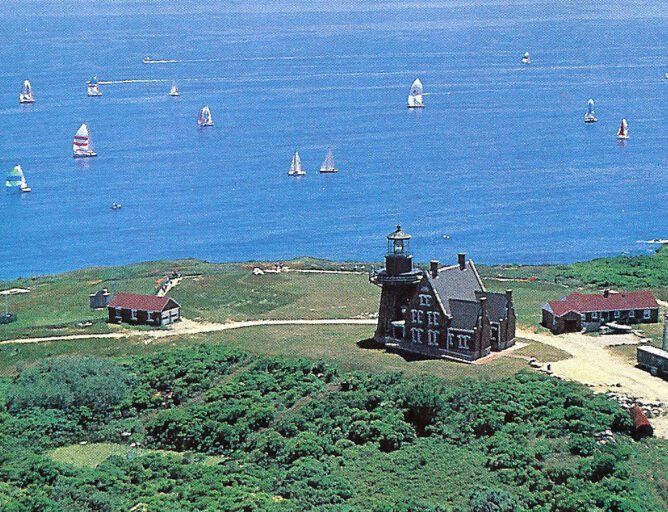EDITOR’S NOTE: This is the second installment of a three-part series chronicling the history of Block Island Race Week. Part 2 looks at the 10 editions of Block Island Race Week from 1985 through 2003.
As the 1970s gave way to the 80s, Block Island was growing alongside the biennial week-long regatta it hosted in mid-June.
When Block Island Race Week began in 1965, New Shoreham had few full-time inhabitants and was a sleepy village that did not truly come to life until the July 4th weekend. By the time the 1985 edition of Block Island Race Week began, the island was a New England summer destination.
Due in part to the popularity of Race Week, Block Island saw a steady increase in tourism throughout the summer, which led to more hotels, restaurants, shops and other businesses.
Sailors participating in the 1985 edition of Block Island Race Week found that Old Harbor was far more developed than it had been 20 years beforehand. John Storck Jr., a regatta regular since 1967, recalled that businessman Aldo Leone was at the forefront of catering to the tourism industry.
Aldo’s Ice Cream Shop opened in 1983 and was joined by t-shirt stores, gift shops and kite makers among other new businesses. “It was interesting to see Block Island gradually change and develop. A lot of the businesses you would find in the eighties weren’t there in the sixties or early seventies,” Storck Jr. said.
Edwards “Buttons” Padin did his first Block Island Race Week in 1973 as crew aboard Gusto, a Pearson 36 owned by Dave Elwell. Padin, who would go on to compete in 17 editions of Block Island Race Week, remembered when an upscale restaurant opened inside the 1661 Inn.
“It was a breath of fresh air because, before that, the dining options were pretty much Ballard’s and Dead Eye Dick’s,” Padin said. “Block Island has grown up dramatically since the 1960s. The whole downtown at Old Harbor has really developed.”
Things were changing on the water as well. Up until 1985, competition at Block Island Race Week was confined solely to handicap classes under the IOR, IMS, MHS, PHRF and MORC rating systems.
One-design racing was introduced in 1987 when the J/35 class was added to the regatta lineup. Subsequent Race Weeks saw a significant increase in one-design starts with Newport, Rhode Island-based J/Boats introducing its J/44, J/109, J/120 and J/105 designs at Block.
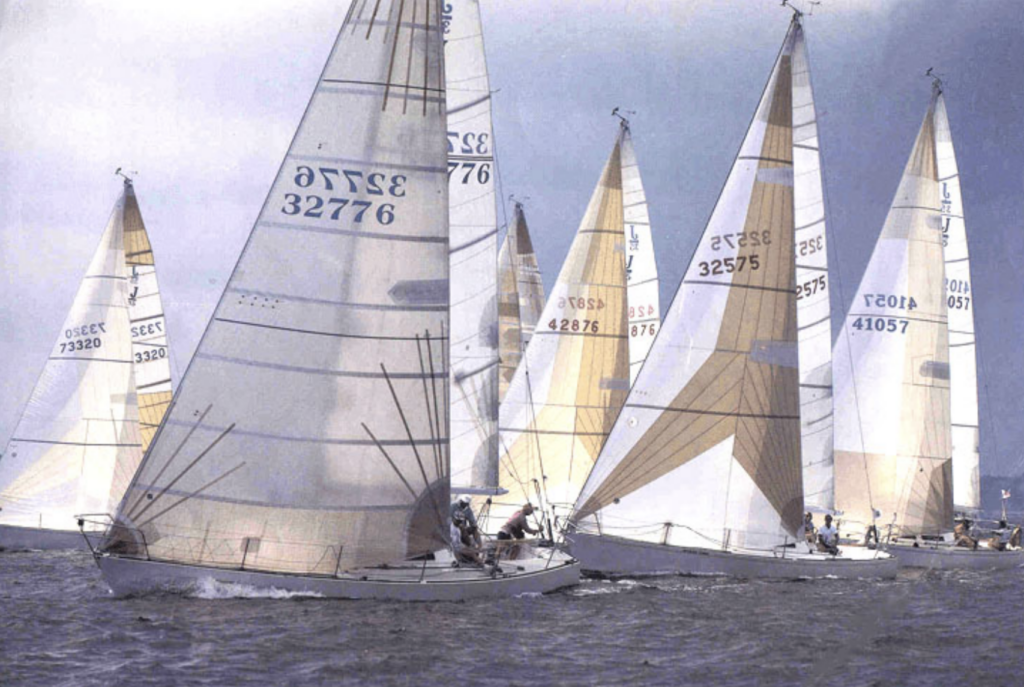
Designed by Rod Johnstone and first built by Tillotson Pearson in 1983, the J/35 was the breakthrough boat that ushered in a new era. Many competitive owners liked the idea of racing identical and evenly matched one-designs as opposed to under a rating rule
Within a few years of being launched, the J/35 was the hottest design on the grand prix circuit and routinely attracted 30 boats to major regattas such as Block Island Race Week. Renowned professionals such as Scott Allan, Paul Cayard and Kenny Read among others were calling tactics for owners in the class.
Frithiof Norris “Sag” Sagerholm was J/35 champion at Block Island Race week for three straight editions, earning the Everett Morris Trophy for best overall performance in 2001. Jimmy Sagerholm often steered Aunt Jean for his father and remembers getting a Rolex watch for being “Boat of the Week.”
“We bought brand new sails, installed a new mast and basically started winning everything. We were really, really fast,” the younger Sagerholm said. “We went to Block Island and had straight bullets in the buoy races. On Friday, they held the Roun-the-Island Race and I didn’t want to do it because we had the regatta wrapped up. My father insisted on racing and we wound up finishing third overall behind two Farr 40s. The race committee couldn’t believe it!”
Jimmy Sagerholm first did Block Island Race Week in 1987 at the age of 27. Sag Sagerholm had a completely amateur program with the crew consisting of family and friends from his hometown of Ocean City, New Jersey. There were so many J/35s on the line that race committee chairman Butch Ulmer strictly enforced a starting sequence in which boats lined up in two rows.
“All the top pros were sailing in the J/35 back then. You would walk down the docks and there was a who’s who of America’s Cup guys,” Sagerholm said.
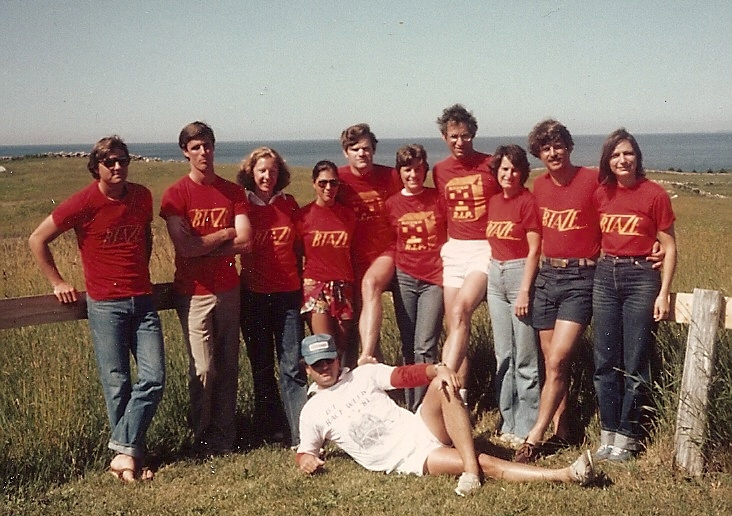
The Aunt Jean program featured a group of fun-loving sailors who knew how to have some fun during the lay day, a scheduled day midweek for some time off. Sag Sagerholm owned a Toyota van with a roof that slid open and the entire crew would pile into it and cruise around the island.
“We called it ‘Giraffe Tours’ because we stood on the seats and put our heads up through the roof,” Sagerholm said. “My wife would always drive because we were all drunk.” Deb Sagerholm would take the Toyota down any dusty path she came across and one time got too far off-road. The van bottomed out on a big rock and sliced a hole in the oil pan. They nursed the vehicle to the only gas station on the island and asked the proprietor if he could fix the problem.
“I was desperate to get the van fixed before my father found out,” Jimmy said. “The mechanic welded the oil pan back together in an hour and a half while we drank at a nearby pub.” In years that Aunt Jean won the regatta, Sag Sagerholm treated the crew to dinner at the Spring House. “You’re talking about 11 people showing up really drunk. It wasn’t always pretty.”
There was usually one crew dinner at Ballard’s and another favorite pastime was going to The National Hotel and sitting on the porch for cocktail hour. There were several years in which the Aunt Jean program rented a house across the street from Club Soda, the basement bar that became a favorite hangout.
“Those were fun times and I learned a lot about big-boat sailing in a large fleet at Block Island Race Week,” Jimmy Sagerholm said.
Showcase Event
Bob Johnstone and co-skipper Bill Shore were the inaugural winners of the J/35 one-design class in 1987 aboard a boat named Houqua. Rod Johnstone was the Class 6 champion in 1989 on a J/37 named Jyro, improbably winning the Round-The-Island Race by finding a way to keep the boat moving on a becalmed day when all the other boats had to anchor.
Rod Johnstone is understandably proud of the J/Boats tradition and success at Block Island Race Week and praised the Storm Trysail Club for its outstanding stewardship of the event. “Block Island Race Week has been a great regatta for J/Boat sailors. The Storm Trysail Club does a great job running the races and our owners have always loved everything about the event,” he said.
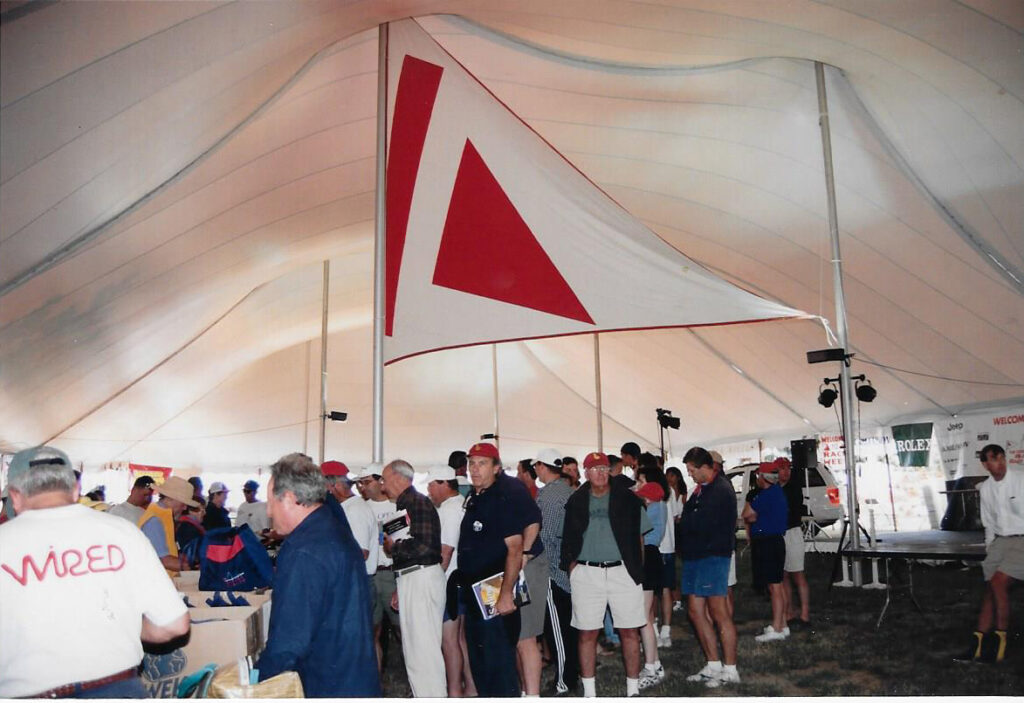
Rod Johnstone is doing the 2023 Block Island Race Week presented by Margaritaville with his son Jeff on the J/99 Upbeat as part of a family crew consisting of three generations. When it is over, he will have competed in 21 of the 30 editions of the regatta.
Annapolis-based Farr Yacht Design also saw Block Island Race Week as an ideal regatta to showcase its latest race boats such as the Mumm 36, Mumm 30 and Farr 40. Geoff Stagg, who oversaw class development for Farr Yacht Design, said that was purposeful.
Stagg noted that Carroll Marine built all the Farr one-designs and that owner Barry Carroll was a strong supporter and big believer in Block Island Race Week.
“We always targeted getting a new boat into the water around April or May to do some tuning and get things sorted. The whole object was to take them to Block Island to show and sell,” Stagg said. “Block Island was a very important target regatta for many reasons. We sold a lot of boats based on their performance at Block Island Race Week.”
For the Mumm 36, which was selected as a class for the Admiral’s Cup, Block Island proved to be a great training ground. That’s because the conditions in terms of winds and tides were very similar to the Isle of Wight, as the Admiral’s Cup was based out of Cowes.
“Block Island provided a really good simulation of the Admiral’s Cup,” Stagg said. The Mumm 36 debuted at Block Island Race Week in 1995 with skipper Peter Vessella sailing Rhody Express to victory. It was followed two years later by the Mumm 30 with owner Barry Allardice winning aboard USA 48.
“The Mumm 30 was totally revolutionary,” Stagg said. “We were very much the new kids on the block and pissing people off with these super-fast, high-performance race boats that had non-overlapping jib, no runners, carbon rigs, a big main and big rudder.”
Carroll was concerned the Mumm 30 would struggle sailing upwind in the typical conditions of the northeast. That turned out not to be the case with a pair of Mumm 30s finishing first and second in the Round-The-Island Race.
The Farr 40 was added as a one-design class at Block Island Race Week in 1999 with a dozen boats on the start line. Owner-driver John B. Thomson Jr. captured class honors aboard Solution, adding to his tremendous success at the regatta.

Corinthian Spirit
Thomson was a class winner at Block Island Race Week in three different decades, previously posting superb results aboard a Nelson-Marek 47 named Infinity. The longtime resident of Manhasset on the north shore of Long Island rarely missed the regatta.
Tom Whidden, a member of the America’s Cup Hall of Fame and National Sailing Hall of Fame, called tactics for Thomson for many years on a series of race boats. “John was a dyed-in-the-wool Storm Trysail Club member and absolutely loved doing Block Island,” said Whidden, CEO of North Technology Group. “John really cared about the Club and was keen to support all of its events. Block Island Race Week was always the highlight of his racing calendar.”
Thomson was blessed with a loyal and devoted crew led by longtime boat captain Tony Reaper and including the likes of Chuck Brown, Gould “Stretch” Ryder and Ralf Steitz. He was infamous for almost always being late for the dock call and it was routine for Infinity to barely make it to the start line on time.
“John was the kindest, most generous guy I’ve ever met. He had a great sense of humor and there was always something to laugh about when you sailed with him,” Whidden said. Thomson, who died in 2014 from ALS-related complications, was chief executive officer and chairman of Thomson Industries, a company founded by his father, who invented the linear motion ball bearing.
Ryder was a pilot and flew Thomson and his family to Block Island aboard a helicopter. In later years, he brought a 150-foot motor yacht named Affinity to race week, providing the crew with comfortable accommodations right down the Champlin’s dock from the sailboat.
“John hosted some tremendous parties on the powerboat after the day’s racing,” Whidden said. “John really knew how to do Block Island Race Week the right way.”
Buttons Padin was a beneficiary of Thomson’s kindness and generosity. In 1985, he crewed aboard a Frers 55 named Jubilation with Gary Jobson as skipper and Mike Toppa as tactician. After returning to port following the opening day of racing, Padin called home to check in with the babysitter and received bad news. A German shepherd the babysitter had brought to the house had bitten Padin’s daughter.
Naturally, Padin and his wife were very concerned and wanted to get back to New Rochelle as soon as possible, which was not possible since the next ferry to the mainland was in the morning.
“John Thomson had a helicopter and flew my wife to West Chester Airport,” Padin said. “We were extremely grateful to him for that gesture.”
Padin, who spent 40 years working at Dancer, Fitzgerald and Sample advertising agency on Madison Avenue before becoming marketing director for ESPN, is among a large contingent of Larchmont Yacht Club members who have been the backbone of Block Island Race Week.
Over the years, Padin has raced with owner Jochim Schultz-Heich on a Ted Hood One-Tonner named Andiamo Robin, with Paul Hoffman on his Rhodes 58, Thunderhead and with Jeff Neuberth aboard the S&S 68 Boomerang. He remembers routinely doing the feeder race from Indian Head, then turning left and heading into Newport to load up with supplies.
The boat would be loaded with groceries and other necessities as it pulled into the Great Salt Pond a few days before the start of race week. Secured to the bow was a crate of lobsters that would provide a delicious crew meal.
In 1997, Block Island Race Week welcomed a special visit from a pair of Whitbread 60-footers. Skipper Dennis Conner and the Toshiba team along with the Chessie Racing crew had been training in nearby Portsmouth in advance of the 1997-98 Whitbread Round the World Race.
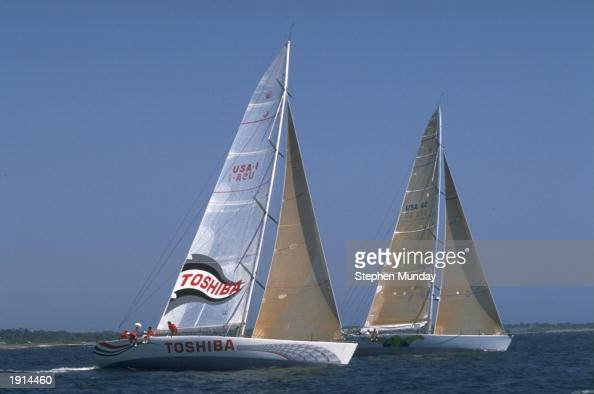
Block Island organizers invited the two vessels to participate in Race Week, adding some spectacle to the event. Conner and Chessie Racing CEO George Collins accepted and the two Whitbread 60s competed in the Round-the-Island Race.
“Toshiba would never match up with us while we were out on the water practicing. Dennis believed he had a better boat and better crew and was afraid we would learn from them,” Collins said.
Toshiba beat Chessie in the Round-The-Island Race after having already inflicted an insult of sorts. Collins had a special Cheesie Racing mooring delivered to Block Island and anchored safely in the Great Salt Pond where a boat with a 13-foot draft could navigate.
“Toshiba beat us to Block Island and Dennis stole our mooring. We got into the harbor and found Toshiba hanging off our mooring,” Collins said. “Dennis later apologized.. sort of.”
Family Affair
Block Island Race Week is part of the fabric of the Storck family. John Storck Sr. brought the first of his many boats named JonRob to the regatta in 1967 and the tradition was passed down to his son and grandson.
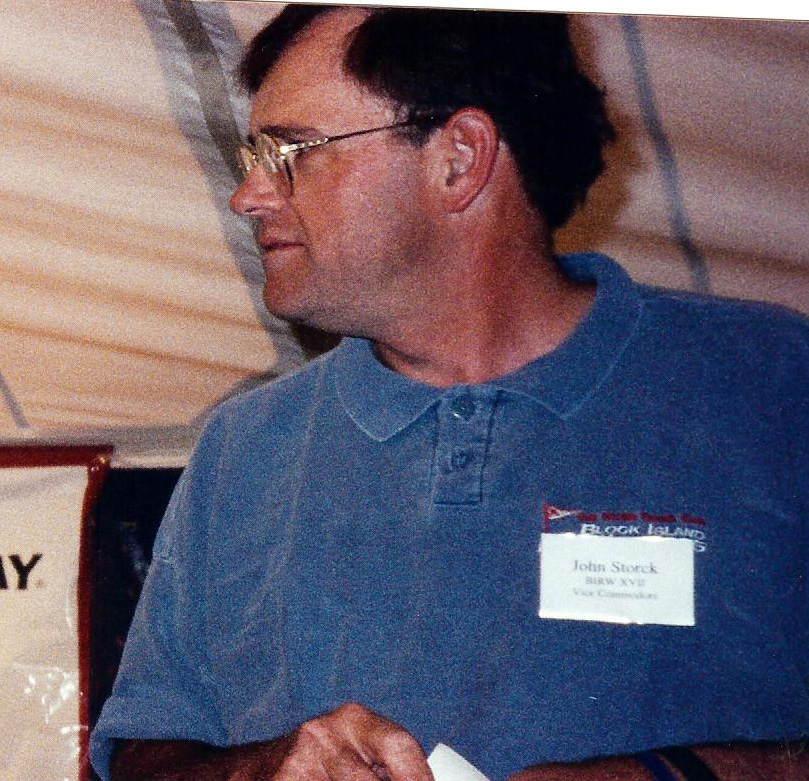
John Storck Jr. even missed his college graduation to crew for his father in the 1971 edition. JonRob, which the elder Storck named for his two sons, was variously a Luders 33, Allied 39 and Erickson 39. That last boat, bought in 1972 from the Arnie Gay Yacht Yard in Annapolis, did Block Island Race Week the most and is now raced by Erik Storck — son of John Jr.
Storck Jr. took over the campaign from his father in 1977 and enjoyed much success at Block Island Race Week, notably earning the Morris Trophy for top performance in 1997. John Storck III, Eric Storck and Katie Potts (nee Storck) all crewed for their father in the family-based program.
“I’m blessed that all three of my children love sailing more than I do,” said John Storck Jr., whose wife Collette was also part of the crew.
Other longtime JonRob crew members included Ford Prime; Gigi Gleason; Charlie Terry, Bobby Storck and Aidan Glackin.
“We had a very, very loyal group of people that sailed with us all the time and became godfathers to our kids,” Storck Jr. said.
JonRob had many great battles with such boats as Not By Bread Alone (Peterson One-Ton, Bill Donovan), Robin (Hood One-Ton, Ted Hood), Emily (Nielsen 44 Ed Gaynor), Second Pirate (Abbott 33, Bill Baxter) and Streaker, a fiberglass boat Halsey Herreshoff had rebuilt and redesigned.
JonRob did its last Block Island Race Week in 2005. The Storck family brought a J/80 to the regatta in 2007 and has been racing in that one-design class ever since.
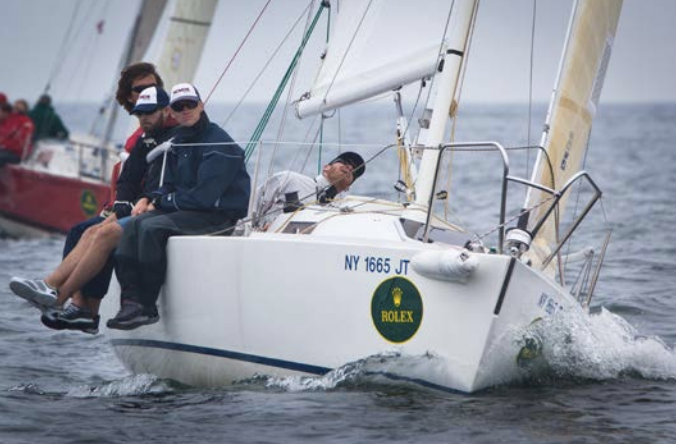
“Up until 1975, we slept on the boat. We had a van parked on the hill at Champlin’s and every morning we’d take the V-berth cushions and other interior up to the van before going out racing,” Storck Jr. said.
Starting in 1977, the Storck family rented a house on the southeast end of the island off Sands Pond Road. It was reportedly the second-highest spot on Block Island behind Pilot Hill. The house was surrounded by pastures filled with cows.
Beginning in the late 1980s, the Storck family stayed aboard a Hatteras 50-foot powerboat named Tonic that was berthed at Payne’s Wharf.
Storck Jr. remembers when the New London Ferry still came into Payne’s Wharf and when the Dixieland band played inside the tent at night and on a houseboat in the harbor each morning.
There was a period in the 1990s when Block Island Race Week experienced declining participation and rising costs. Butch Ulmer was regatta chairman at the time and called a meeting of high-powered Storm Trysail Club members.
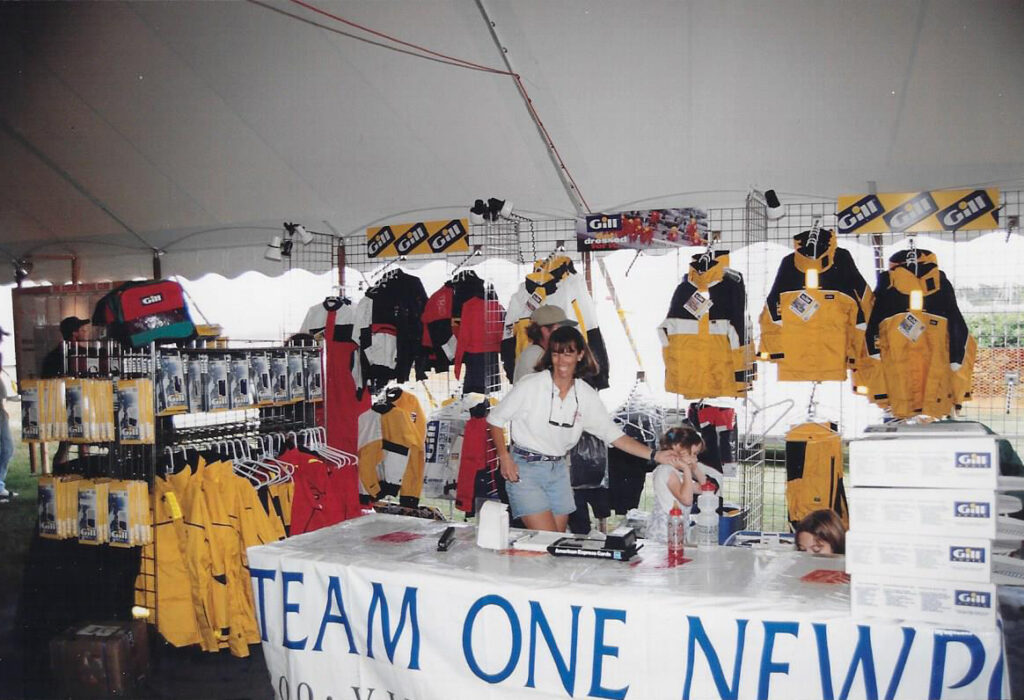
Ulmer declared that in order to survive and once again thrive, Block Island Race Week would need to solicit sponsorship. Storck Jr., who has always been in the automobile business, convinced Jeep to sign on as a lead sponsor.
When Storck was set to become Regatta Chair, he sought to shore up the financial side of Block Island Race Week even further. He made a special trip to Block Island and met with the Chamber of Commerce.
“There was a wonderful lady named Joan Abrams and she understood the importance of Race Week to the Block Island economy,” Storck Jr. said. “Joan rallied the business community to support Block Island Race Week and that was the beginning of the model we have now.”
Storck has competed in 25 of the 29 editions of Block Island Race Week held to date, the second most of any sailor or volunteers, with Jeff Willis holding the record with 27.
In 2021, the Storm Trysail Club honored the long-time loyalty of Block Island Race Week participants by creating the North Light Society (named for the Lighthouse that greets sailors on their way to Block Island.)
Block Island Race Week continued to thrive and grow as it entered the new millennium. With participation and sponsorship growing, the regatta became the last true Race Week in America thanks to the continued loyalty and support. Stay tuned for the next installment of Race Weeks 2005-2023!

